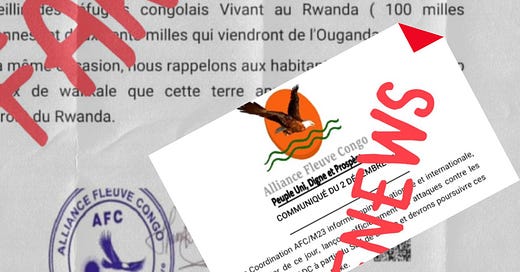DRC: The Fake Call Attributed to M23 to Launch Attacks Against FARDC
A recent press release purportedly from the Alliance Fleuve Congo/M23 has gone viral, claiming that the M23 rebels have launched attacks against the Armed Forces of the Democratic Republic of Congo (FARDC) and Southern African Development Community (SADC) forces. It also alleges that Congolese refugees in Rwanda and Uganda are set to return en masse to North Kivu. This press release has been widely discredited as fake, and here, we will dissect the claims and offer verified facts to debunk this piece of misinformation.
Verifiable Facts About the Resumption of Hostilities in North Kivu
First and foremost, credible sources such as the United Nations ( MONUSCO), the International Crisis Group, and reputable news outlets confirm that the security situation in North Kivu is indeed volatile. However, the claim that M23 has officially launched coordinated attacks on FARDC and SADC forces, starting from South Lubero to Goma, lacks any substantiated evidence. No official statements from the M23 leadership or other credible organizations corroborate this assertion.
Additionally, the timeline and specifics of these supposed attacks do not align with verified reports from the ground. According to international observers, while tensions persist, no large-scale coordinated assaults involving SADC forces have been reported recently.
Misconceptions and False Claims About the Eastern DRC Conflict
Misinformation about the conflict in Eastern DRC often exploits deep-seated ethnic and political divisions. A common falsehood is that the conflict is solely driven by Rwanda’s alleged support for the M23 rebels. While the UN has reported instances of external support for armed groups, it is an oversimplification to attribute the entire conflict to Rwandan involvement.
Another prevalent myth is the narrative that M23’s actions are aimed solely at securing land for specific ethnic groups. The conflict stems from a complex interplay of historical grievances, resource competition, and weak governance.
Refuting the Press Release’s Claims
The press release’s claim that Congolese refugees in Rwanda and Uganda are preparing to return to North Kivu en masse is not supported by any credible data. The United Nations High Commissioner for Refugees (UNHCR) has not issued any statements about such movements, and recent reports from refugee camps in Rwanda and Uganda indicate that the situation remains stable.
Moreover, the assertion that land in South Lubero and Walikale belongs exclusively to Rwandan refugees is both historically inaccurate and incendiary, designed to stoke ethnic tensions and incite violence. Historical land disputes in the region are far more nuanced, involving various local actors and issues.
The Consequences of Spreading Fake News
Disseminating false information about the return of refugees or land ownership can have dire consequences. Such claims can inflame ethnic tensions, provoke violence, and disrupt ongoing peace efforts. In a region already suffering from displacement and humanitarian crises, fake news further undermines trust between communities and hampers the work of peacebuilding organizations.
Fact-Checking Information Related to the Eastern DRC Conflict
To counter misinformation effectively, it is crucial to fact-check claims rigorously. Here is a step-by-step guide:
Cross-Reference Sources: Verify information by consulting multiple credible sources, including UN reports, reputable media outlets ( BBC, VOA, RFI, DW, and expert analyses.
Check Official Statements: Look for statements from recognized institutions like the UNHCR, MONUSCO, or government bodies.
Assess the Credibility of the Source: Evaluate the source’s reputation, past accuracy, and potential biases.
Use Fact-Checking Tools: Platforms such as Congo Check, Africa Check and Ukucri Check specialize in verifying claims about the DRC.
Psychological Factors Behind the Spread of Fake News
Fake news about Rwanda and M23 persists partly due to cognitive biases, such as confirmation bias, where individuals are more likely to believe information that aligns with their pre-existing views. Emotional triggers, such as fear and anger, also play a significant role in spreading disinformation.
Conclusion
In today’s fast-paced media environment, fake news and disinformation can spread like wildfire, often exacerbating conflicts and misleading the public. The spread of fake news, like the recent disinformation about the M23 rebels and Congolese refugees, poses a serious threat to peace and stability in Eastern DRC. By critically examining such claims, relying on verified facts, and promoting media literacy, we can combat the harmful effects of misinformation and support efforts for a more informed and peaceful society.





